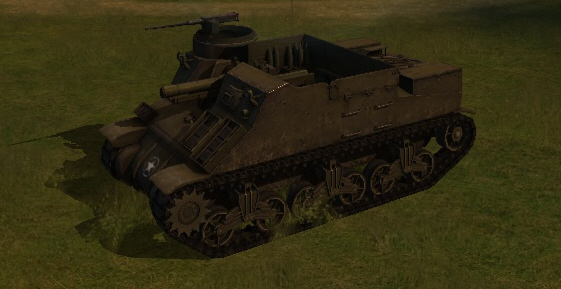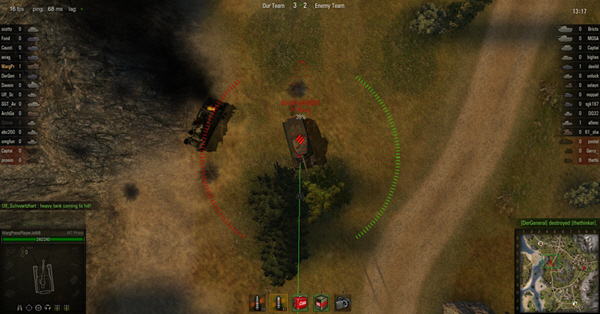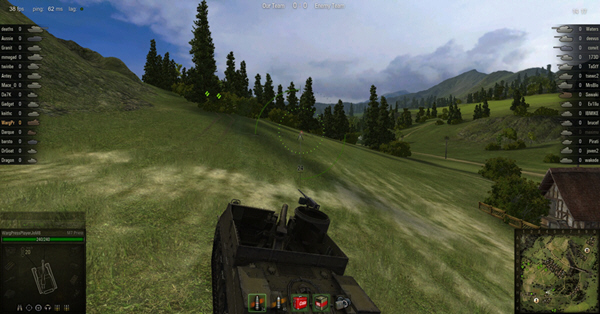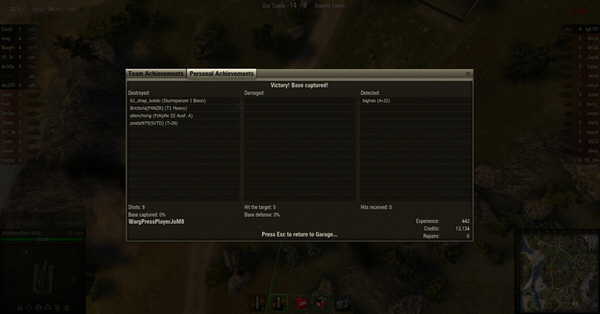Strategy Guide: World of Tanks – Confession of a Priest
 World of Tanks – Confessions of a Priest. Strategy Guide. Publisher: Wargaming.net. Free-to-Play.
World of Tanks – Confessions of a Priest. Strategy Guide. Publisher: Wargaming.net. Free-to-Play.
World of Tanks is a free-to-play game but players can spend money to accelerate their progress through the game. Players can spend real money to buy in-game gold which can then be spent toward upgrading tanks or purchasing a Premium account, which increases credits and experience by an additional 50%. Guys who spend a lot of money doing this are called “Wallet Warriors” by some. Frankly, I don’t quite understand the envy. The “Wallet Warriors” are the ones who make the free game free. Without paying customers great games like World of Tanks wouldn’t, well, be free.

The challenge of the SPG is to be relevant without being a casualty.
Recently I accessed a press account in order to revisit World of Tanks. I hadn’t played it since the Beta in January and I wanted to see how the game had matured. As I expected it had only improved, but as a side-effect of my press account, I realized I was something of the ultimate “Wallet Warrior.” My press account was loaded with Gold and Experience. As with my experience with the Beta, I was able to build any tank I wished, and pretty much as many as I wished. Unlocking the tech tree was simply a matter of clicking on all the upgrades until I arrived at the desired tank.
{default}One of my first goals was to max out the top-tier heavy Russian tank, the IS-7. It’s a monster level 10 tank, with sloped armor capable of absorbing enormous amounts of damage, and its 130mm gun deals out as much as 613 points of damage, making it a real beast. It can be a lot of fun rolling around in the IS-7. Used in conjunction with three or four weaker heavy tanks it can seal the deal in an armored spearhead.

Fun as it is to be Top Dog in a maxed out heavy tank, the fact is I often have more fun rolling around in a mid-tier tank. I often enjoy playing with the Self-Propelled Guns (SPG), the mobile artillery in the game. SPGs should be used in a support role only. Their armor is so weak that typically only a single shell is required to take them out of action. Going head-to-head with a tank is a situation that I’ve never won. I’m sure under the right circumstances using them as direct-fire Tank Destroyers can be successful, but they are best suited to hanging behind the lines and using indirect fire.

In that capacity SPGs, if used properly, can tip the scales of a battle. Again, having a press account, my first reaction was to build out a monster SPG. Initially I chose the American T92. Boasting an enormous 240mm howitzer, the T92 is capable of dealing out over 2800 points of damage. The downside to this powerhouse is that it dishes out about one round a minute. Given the sluggish reload rate, players have to take serious consideration into their targeting. I have played several games where my T92 hit nothing. Considering the punch it carries, that is a burden that no player wants to carry.

So after a few games with my T92 I decided instead to move down the tech tree. That might strike some players as odd, considering I can fill over a dozen slots with maxed-out elite tanks of every nation and class if I so choose. Truth be told, I am finding it much more satisfying to play mid-level games with a mid-level SPG. One of my favorite SPGs from World War Two is the M7 Priest. In World of Tanks this is a speedy little guy with a rapid reload time (about twelve seconds per round). The 105mm howitzer can pound out as much as 500 points of damage with each shell, meaning that on a per-minute basis it can potentially match the damage dealt by behemoth SPGs.
The downside to the Priest is that the 105mm howitzer doesn’t have the range to hit everything on the map without moving closer to the action. Placed in the middle of the map it can hit pretty much anywhere, but the Priest is an SPG and SPGs are easy pickings for any tank that sees you. Training crew members to repair an SPG is a waste; most SPGs don’t survive a first shot, and if you do, you’re almost guaranteed to take a second shot before help arrives. In a word, you’re a dead duck. Instead I train them in camouflage. It doesn’t make a big difference, but it can help. The best strategy for an SPG is to shoot and scoot. It isn’t difficult to ID where the shots are coming from, and moving every few shots can make the difference between surviving the round and not.
However, that moving around comes at a cost, and it needs to be weighed against the impact you’re contributing to the game. If you’re helping damage tanks and they’re quickly falling, the best move may be to stay where you are, moving up only when the enemy is beyond the range of your 105. With the rapid fire and hefty damage, the Priest’s fire can tilt the balance of the game. And with its indirect fire it can sometimes reach places where enemy tanks are sheltering and can’t be hit by teammates in direct contact. Another aspect of playing the Priest is how quickly games can be found. With the T92 I have sometimes waited as long as three minutes for a match. With the Priest I find games in seconds – sometimes almost instantly.

Not all maps are well suited for SPGs. Urban maps can often block even steep indirect fire. Tanks that hug walls will often find themselves sheltered from plunging fire. The Himmelsdorf map in particular is one I never want to see loaded when playing an SPG. Another map is Ruinberg. Although half of Ruinberg is open terrain, there are precious few places for an SPG to hide. Sheltering in the streets can sometimes block the fire of outgoing shots as well as when they approach the target. With few places to hide it is a challenging map for any SPG. The best bet on Ruinberg is to move into whatever foliage cover you can find on the open side of the map and hope that no scouts punch through your lines.

Karelia can be a difficult map for an SPG, too because there is limited cover. The rocks easily shelter tanks that hug their walls, and SPGs that cling too tightly to them will have their field of fire blocked. Compounding the issue is the limited range of the Priest’s gun.

SPG’s in general, and the Priest in particular, face the challenge of moving up close enough to be able to hit the enemy, but without exposing yourself to enemy guns. The challenge of the SPG is to be relevant without being a casualty. It’s a difficult balance to establish, and easier to establish on forested terrain. The SPG should attempt to prioritize Heavy Tanks and Tank Destoyers. These high value targets can be difficult nuts to crack, but so long as the SPG is sheltered from enemy fire, even medium level SPG’s have a punch that can make a bad day for the heaviest of tanks. When the SPG’s fire is combined with cagey gameplay for the frontline units, it’s an unstoppable synergy. For me, the Priest strikes a great balance between mobility, range, and firepower. The Priest is faster and deals out more damage than either of its Tier 4 counterparts. It is my favorite for a mid-level SPG.
About the Author
Jim Zabek has been wargaming since the age of 10. Boardgames, PC games, or miniatures, he enjoys playing them all. Currently enjoying a revived interest in World of Tanks, he is also playing Call of Duty: Black Ops, Close Combat: The Longest Day, and the recently released Combat Mission: Beyond Normandy.


This actually gives me some good tips to use against SPG’s!
Good read
Great reviews/guides as always on this site. The only thing I wish for is that the PC game section was more often updated.
One small complaint is that in every review you seem critical of us who call these sorts of players wallet warriors or what ever and look down on them.
Here’s the deal. If everyone can’t start out on equal basis in the real world at least they should be able to on the web. To begin with games like LoL do fairly good only charging money for “design” features. If that is not a possibility then charge money for existing tank designs if someone simply feels that they have the skills to drive those tanks from the beginning. To create an unfair atmosphere.
Personally I’d rather pay 20 dollars for the game together with a slight monthly fee instead of this system put in place with additional donations being possible earning you perhaps additional “design” features, clan creation features or signatures on the forum.
I’ve been staying away from this game precisely for the reasons mentioned above and the more arcade feeling it has goten since leaving beta. But despite this I think I am about to download it and play the real version to.
Still I’ll be sure to pile on some flames on those true “wallet warriors” that just keep pouring money in after every loss as I always have. I don’t like them and I never will.
Talk about legitimate cheating…
Hi Boris,
Thanks for the feedback.
We’re working on more gaming content all the time. I’ve got more PC gaming goodies lined up for next week.
As for those who criticize the “wallet warriors” my principle concern is simply this: who pays for the game? If it weren’t for the “wallet warriors” there won’t be a World of Tanks.
I know this is slightly old but I pay 14.95 a month the same rates large MMOG’s ask for. Now just because I don’t pay 300$ for a large some of gold because I actually got to support my self and my family I’m not helping them keep this game up is bs, their wallet warriors because they spend it once and then just unlock everything they want.